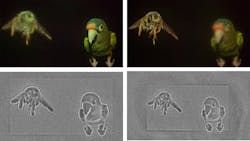Using two spatial light modulators instead of one improves holographic displays
Researchers from NVIDIA (Santa Clara, CA) and Stanford University (Palo Alto, CA) have come up with a way to improve the image quality and contrast for holographic displays.1 The new technology could help improve near-eye displays used for virtual and augmented reality (VR/AR) applications.
Holographic displays have the potential to outperform other 3D display technologies used for VR/AR by enabling more-compact displays, offering the ability to adjust for users who wear corrective lenses, and, importantly, improving users' ability to focus their eyes at different distances (in other words, create the perception of real depth). However, the technology hasn’t yet achieved the image quality of more conventional technologies.
For holographic displays, image quality is limited by the single phase-only spatial light modulator (SLM) used to create the diffracted light that makes the interference pattern needed to form visible 3D images. However, the phase-only SLMs typically used for holography exhibit a low diffraction efficiency that significantly degrades observed image quality, especially image contrast.
Because it is difficult to dramatically increase the diffraction efficiency of SLMs, the researchers designed a new optical architecture to create holographic images: Rather than using a single phase-only SLM like most setups, their Michelson-holography approach uses two phase-only SLMs.
“The core idea of Michelson holography is to destructively interfere with the diffracted light of one SLM using the undiffracted light of the other,” says research team member Jonghyun Kim. “This allows the undiffracted light to contribute to forming the image rather than creating speckle and other artifacts.”
Camera-in-the-loop optimization approach
The researchers combined the new hardware arrangement with a camera-in-the-loop (CITL) optimization procedure that they modified for their optical setup. CITL optimization is a computational approach that can be used to optimize a hologram directly or to train a computer model based on a neural network. This allowed the researchers to use a camera to capture a series of displayed images, which enabled them to correct for small misalignments of the optical system without using any precise measuring devices.
“Once the computer model is trained, it can be used to precisely figure out what a captured image would look like without physically capturing it,” says Kim. “This means that the entire optical setup can be simulated in the cloud to perform real-time inference of computationally heavy problems with parallel computing. This could be useful for calculating a computer-generated hologram for a complicated 3D scene, for example.”
The researchers tested the Michelson holography architecture using a benchtop optical setup, using it to display several 2D and 3D holographic images that were recorded with a conventional camera. The demonstration showed that the dual-SLM holographic display with CITL calibration provides significantly better image quality than existing computer-generated hologram approaches. Making the new approach practical would require translating the benchtop setup into a component that would be small enough to incorporate into a wearable augmented or virtual reality system.
Paper: S. Choi et al., Optica 8, 2, 143-146 (2021); doi: https://doi.org/10.1364/optica.410622.

John Wallace | Senior Technical Editor (1998-2022)
John Wallace was with Laser Focus World for nearly 25 years, retiring in late June 2022. He obtained a bachelor's degree in mechanical engineering and physics at Rutgers University and a master's in optical engineering at the University of Rochester. Before becoming an editor, John worked as an engineer at RCA, Exxon, Eastman Kodak, and GCA Corporation.
